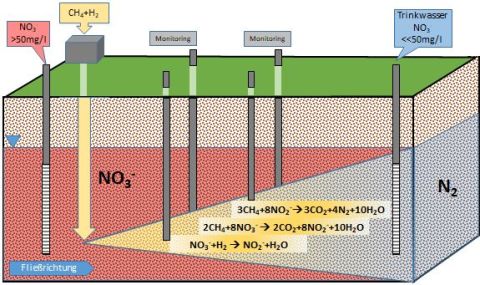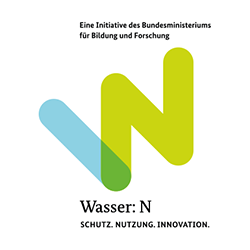Stimulation of H2/CH4 oxidizing bacteria in pore aquifers for purification of nitrate-polluted drinking water and process water
Brief description
The changes in the water cycle caused by climate change call for sustainable management of our water resources. Groundwater is the most important drinking water resource in almost all European countries. As a rule, only near-surface aquifers with high groundwater recharge can be managed sustainably. However, these often have high nitrate contamination. The required self-purification potential against pollutants such as nitrate is often limited by the lack of microbially available electron donors, so that despite a reduction of nitrogen inputs via agriculture, elevated nitrate concentrations can still be observed in aquifers for decades.
Stimulation of denitrifying microorganisms via addition of hydrogen (H2) and methane (CH4) has the potential for significant nitrate reduction in groundwater and could significantly reduce nitrate concentrations in a variety of impacted production wells.
The proposed project will develop, optimize, and monitor the efficient injection of H2 and CH4 gases and record their degradation potential relative to dissolved nitrate in groundwater. First, the degradation potential will be tested in a flume test and later, in cooperation with a regional water supplier, in a test facility at a field site. The project thus develops an active, minimally invasive stimulation of existing ecosystem services on the basis of a natural analysis of nitrate turnover in groundwater and offers the possibility of a socially and economically relevant use of the technology directly following the project.

Objectives
The development and use of high-quality deep water as a drinking and service water resource in the case of a nitrate-related limited possibility of use of near-surface groundwater systems is not provided for in Bavaria (LfU bulletin no. 1.4/6). Therefore, there is a great need for new innovative and inexpensive technologies to make nitrate-contaminated near-surface aquifers usable again for the water supplier in order to be able to meet the constantly increasing demand for drinking and service water from sustainable production in the future and to defuse conflicts of use.
The aim of the research project is to stimulate the denitrifying chemolithoautotrophic microorganisms present in the groundwater for an areal conversion of nitrate to N2 by simultaneous addition of the electron donors hydrogen and methane. Compared to common methods, we expect lower operating costs at higher volume flows and a higher purification efficiency at complete conversion of nitrate to N2 with a simultaneous overall improvement of the qualitative condition of the groundwater ecosystem. We intend to achieve the project goals using a scaled approach that leads from laboratory work and a pilot plant test to numerical simulation and technical plan readiness for an efficient pilot plant.


